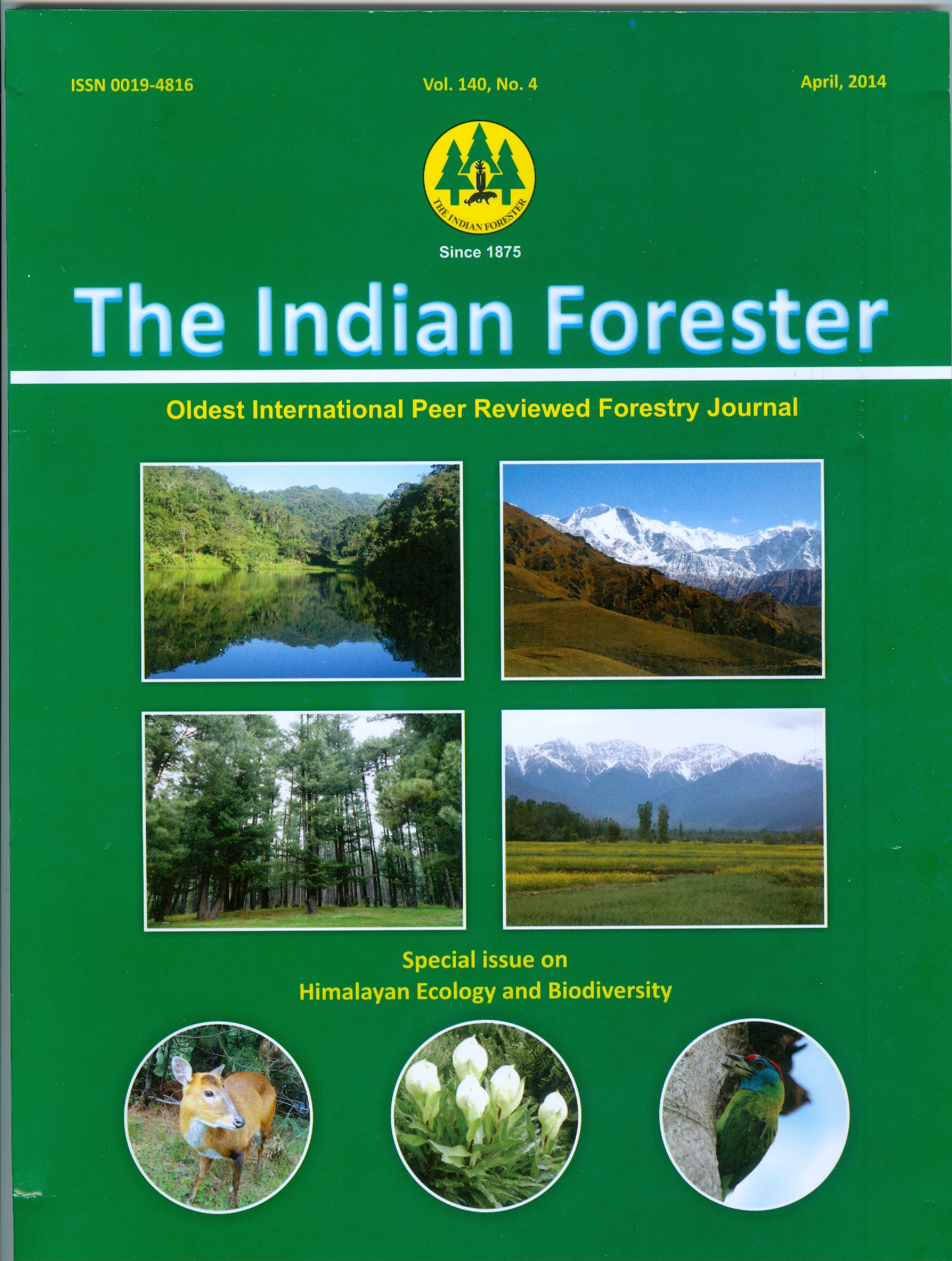Diversity, Disturbance and Regeneration Status of forests along an Altitudinal Gradient in Paddar Valley, Northwest Himalayas
DOI:
https://doi.org/10.36808/if/2014/v140i4/48013Keywords:
Anthropogenic Disturbance, Regeneration, Phytosociology, Temperate ForestsAbstract
The present study deals with the phytosociological analysis, anthropogenic impacts and regeneration status of tree species in five dominant forest types along an altitudinal gradient in Paddar valley of Northwest Himalaya. The tree density varied between 179 to 245 trees/ha whereas the total basal area varied between 24.7 and 37.7 m²/ha in five forest types. The value of Shannon-Weiner index (H') was found maximum for western mixed coniferous forest (1.75) whereas Concentration of dominance (Cd) and Evenness (J') were found maximum for dry temperate deciduous forest (0.41) and dry deodar forest (0.32) respectively. The maximum disturbance was found in the dry temperate deciduous forests due to heavy dependence of the locals on oak, Quercus baloot for fuelwood and fodder. The results pertaining to regeneration status of 18 tree species shows 4 species with good regeneration,6 species with fair regeneration and 5 species with poor regeneration status whereas 3 tree species were found to have no regeneration at all. The regeneration was good for mixed coniferous forest and birch fir forests, poor for broadleaved and coniferous forest and fair for dry temperate deciduous forest and dry deodar forests.References
Anon. (1987-88). Revised working plan for Kishtwar Forest Division, Department of Forest Govt. of Jammu and Kashmir.
Champion, H.G. and Seth, S.K. (1968). Forest types of India.Manager of Publications, GoI, Delhi.
Curtis, J.T. (1959). The vegetation of Wisconsion. An ordination of plant communities. University of Wisconsion press, Madison, Wasconsin.
Dhaulkhandi M., Dobhal A., Bhatt S. and Kumar, M. (2008). Community structure and regeneration potential of natural forest site in
Gangotri, India. J. Basic and Applied Sciences, 4: 49-52.
Gairola, S., Rawal, R.S. and Todaria, N.P. (2008). Forest vegetation patterns along an altitudinal gradient in sub-alpine zone of west Himalaya,India. African J. Plant Science, 2(6): 042-048.
Gupta, R.K. (2004). Impact of human influences on the vegetation of the Western Himalaya. Plant Ecology, 37(2): 111-118.
Harish, S. (2007). Himalayan yew (Taxus wallichiana): A multipurpose rare gymnosperm in India. Indian Forester, 133(5): 690-696.
Kiran H.S., Kapahi B.K. and Srivastava T.N. (1999). Taxo-Ethnobotanical observations on the gymnosperms of Poonch district (J&K), India. J.Econ. Taxon. Bot., 23:155-160.
Krizc M., Newman R.F., Trethewey C., Bulmer C.E. and Chapman B.K. (2006). Cattle grazing effects on the plant species composition and soil compaction on rehabilitated forest landings in central interior British Columbia. J. Soil and Water Cons., 61:137-144.
Kumar S. and Hamal I.A. (2009). Wild Edibles of Kishtwar High Altitude National Park in Northwest Himalaya, Jammu and Kashmir (India).Ethnobotanical Leaflets, 1:195-202.
Misra, R. (1968). Ecology workbook. Oxford and IBH Publishing Co. Calcutta, pp.224.
Pandey, J.C. (2003). Vegetation analysis in a mixed oak-conifer forest of central Himalaya. Ind. J. Forestry, 26(1):66-74.
Phillips, E.A. (1959). Methods of vegetation study. Henry Hold and Company, New York.
Pielou, E.C. (1966). The measurement of diversity in different types of biological collections. J. Theo Biol., 13:131-144.
Rawat, V.S. and Chandhok, A. (2009). Phytosociological analysis and distribution pattern of tree species: A case study of Govind Pashu Vihar, National park, Uttarakhand. New York Science Journal, 2(4):58-63.
Rikhari, H.C. and Adhikari, B.S. (1998). Population structure and protective value of temperate forests in a part of Central Himalaya. J.Sustainable Forestry, 7(3): 5-21.
Saxena A.K. and Singh J.S. (1982). A phytosociological analysis of woody species in forest communities of Kumaun Himalaya. Vegetation,50:3-22.
Sen A., Johri T. and Bisht N.S. (2008). Analysis of the effects of anthropogenic interference on tree species composition in the forests of Dadra and Nagar Haveli, India. Current Science, 95:50-58.
Shannon, C.E. and Wiener, W. (1963). The mathematical theory of communication. University of Illinois Press, Urbana, Illinois, USA.
Sharma, S., Sharma, R. C. and Kant, S. (2008). Assessment of biotic interference and ecological degradation in Birhum Watershed, Jammu and Kashmir. Environment and Ecology, 26(4): 1539-1544.
Simpson, E.H. (1949). Measurement of diversity. Nature, 163: 688.
Wangda P. and Ohsawa M. (2006). Structure and regeneration dynamics of dominant tree species along altitudinal gradient in a dry valley slopes of the Bhutan Himalaya. Forest Ecology and Management, 230:136-150.
Downloads
Downloads
How to Cite
Issue
Section
License
Unless otherwise stated, copyright or similar rights in all materials presented on the site, including graphical images, are owned by Indian Forester.





